Sabudana Vada Recipe (For Fasting)
Sabudana Vada, one of our favorite fasting snacks is a crispy, soft, savory and mildly sweet patty featuring softened tapioca pearls (sago), mashed potatoes, crunchy peanuts, fragrant spices and fresh herbs. It is naturally gluten-free and vegan. This foolproof Maharashtrian style Sabudana Vada recipe gives you a super delicious, crispy vada with a soft and light interior and can be made as a fasting or vrat snack.
About Sabudana
Sabudana known as sago are circular, small white pearls made from the roots of the cassava plant (tapioca, yuca). They are also called tapioca pearls and are eaten during the Hindu fasting period.
The word “sabudana” is a Hindi word and a common term used for these white tapioca pearls in North, Central and Western India.

In the South Indian regional languages, these are called javvarisi (Tamil), sabbakki (Kannada), chowari (Malayalam) and sagubiyyam (Telugu).
Basically sabudana is pure starch and thus obviously is heavy on carbs. They keep you full for a longer period and this is the reason they are included in the fasting food.
In the Indian Hindu tradition, the Shravan month, Ekadashi days, Mahashivratri Festival and the Navratri period are times when many devout Hindus keep a fast (vrat/upvas).
The food that is taken during the fast does not contain onions, garlic, wheat products, lentils or pulses.
During this time a few recipes are made from these sago pearls. Sabudana vada is one such dish, apart from the popular Sabudana Khichdi.
About Sabudana Vada
Sabudana Vada are deep fried crispy patties with a soft and fluffy interior. They are made with tapioca pearls, potatoes, roasted crushed peanuts, few spices & herbs, and seasoned with lemon juice, sugar and salt.
The white tapioca pearls or sabudana are soaked in water for several hours, which helps them to soften and get mashed easily. The potatoes are cooked first and then mashed or grated or finely crumbled.
The softened sabudana is evenly mixed with the mashed potatoes, roasted crushed peanuts with a few herbs and spices. Round patties are formed from this mix which are deep fried.
The starch in the cooked potatoes aid in binding the patty mixture and the vada does not crumble or fall apart while frying. Peanuts add a lovely crunch to the patties and the herbs and spices make them more flavorful.
About My Recipe
My sabudana vada recipe is an authentic Maharashtrian recipe that I learnt in my cooking school decades back. This recipe makes for delish sago patties with a lovely golden crisp texture (as you can see from my photos) and a wonderful soft center.
It is a satvik recipe, meaning I do not add onions or garlic and a lot of spices – but these are fried. This sabudana vada recipe is fool-proof, fail-proof and can be easily made by beginners.
The proportion of ingredients mainly of potatoes and sago is perfectly balanced in this sabudana vada recipe. These perfect proportions helps you to bind and form the patties effortlessly.
You won’t not end up with a soggy or broken batch of the patties. Plus you can easily shape the patties without the need to add any flour for binding.
Roasted peanuts are also traditionally included and they add a beautiful touch of nuttiness and sweetness in the vada. Not to forget some protein boost.
Sabudana vada can be enjoyed as a brunch or an evening snack as well. In Mumbai, one will find many sweet shops selling this tasty snack.
In fact, it is a street food in Mumbai as well as Maharashtra and many shops and street vendors sell these crispy tasty snack.

How to make Sabudana Vada
Soak Sabudana
1. You need to plan ahead and soak the sago pearls. It is very important to soak the sago really well. Well soaked sabudana make for a soft, light and fluffy vada.
Important: Please refrain from using un-soaked or under-soaked sabudana to avoid scalding or burns as they will burst and shatter in oil when frying.
First, using a colander or mesh strainer rinse 1 cup sabudana lightly twice or thrice draining all the water. Then soak the rinsed pearls in 2 to 2.5 cups water for 5 hours at least or overnight.
I always soak them overnight and by morning they become nicely soft. Some varieties of sabudana can also be soaked for 2 to 3 hours. I get a really hard textured sabudana and soaking them for 2 to 3 hours does not help.
So depending on the quality of your sabudana, soak for 2 to 3 hours or more. To test that they have soaked and softened really well, follow the points mentioned in the second step below.

Check Soaked Sago
2. When properly soaked, the sabudana pearls will be tender without any hard center. When you press the pearls between your forefinger and thumb, they would get mashed easily with a floury texture on your fingers.
If you feel some hardness in the center, then soak for some more time. When they are softened well, drain all the water from the soaked sabudana.
Remember not to use the sabudana pearls if they are not soaked well or have a hard center. These under-soaked sabudana will splatter or burst in the hot oil when frying.
Keep in mind that there should not be any water logged in the soaked pearls. Water will definitely make the patties moist and sticky.
Hence these waterlogged patties will soak up a good amount of oil while frying making them loaded with oil. Also a lot of water in the patties may cause them to shatter or fall apart in the oil during deep frying.
So drain the water really well. You can opt to gently and lightly press the soaked pearls in the strainer with a spoon or spatula. Or set aside the pearls in a strainer (keeping a bowl beneath) for some 20 to 30 minutes dripping of any extra water.
Use this time to prep your other ingredients. This is what I do. I let the soaked pearls sit in the strainer and begin to cook the potatoes and prep the other vada ingredients.
Handy Tip: If in case you find the soaked sabudana has too much of moisture even after straining well, add some flour to the patty mixture like – buckwheat flour, amaranth flour, water chestnut flour. These flours will help absorb the excess moisture from the sago pearls.
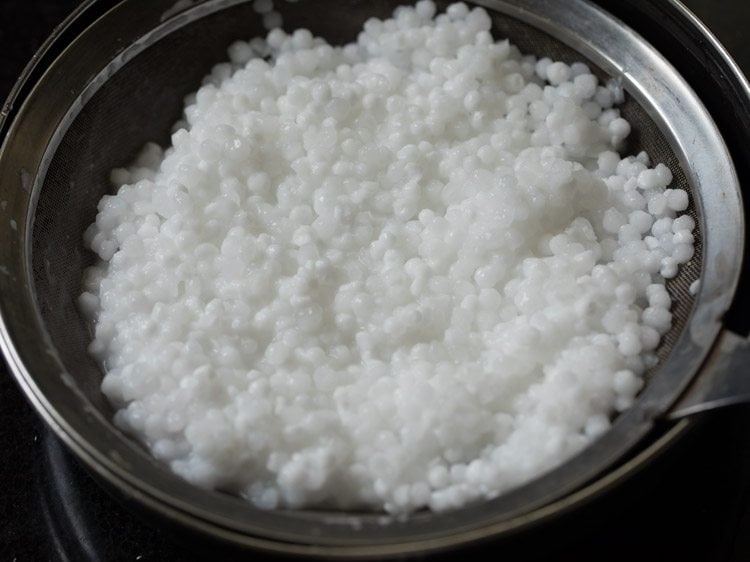
Cook Potatoes
3. Scrub and rinse 4 medium-sized potatoes thoroughly in water first. Then place the potatoes in a 3 litre cooker. Add water which just about covers the potatoes.
Note that you can choose to cook potatoes in a pan or in an Instant Pot.
1. If cooking in a pan, take water and add peeled and chopped potatoes. The water should cover the potatoes. Add a 2 to 3 pinches of salt if preferred. Cover and simmer potatoes until fork tender. Later drain the water really well and set the cooked potatoes aside.
2. For Instant Pot cooking, place a trivet in the inner steel insert of your Instant Pot. Add 1.5 cups water. Place the rinsed potatoes on the trivet. Seal with the lid and position the valve to sealing. Press the manual/pressure cook button and set the time to 10 or 12 minutes with high pressure option.
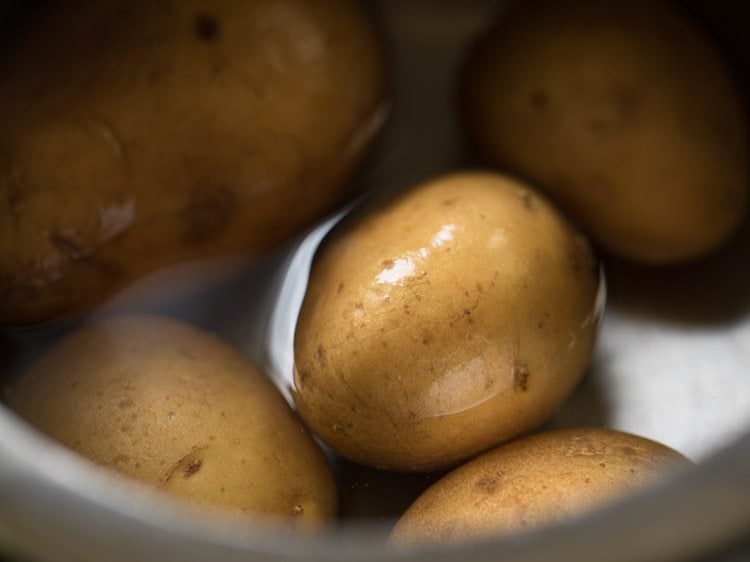
4. For the stove-top pressure cooker, boil potatoes for 10 to 12 minutes or 4 to 5 whistles on medium-heat.
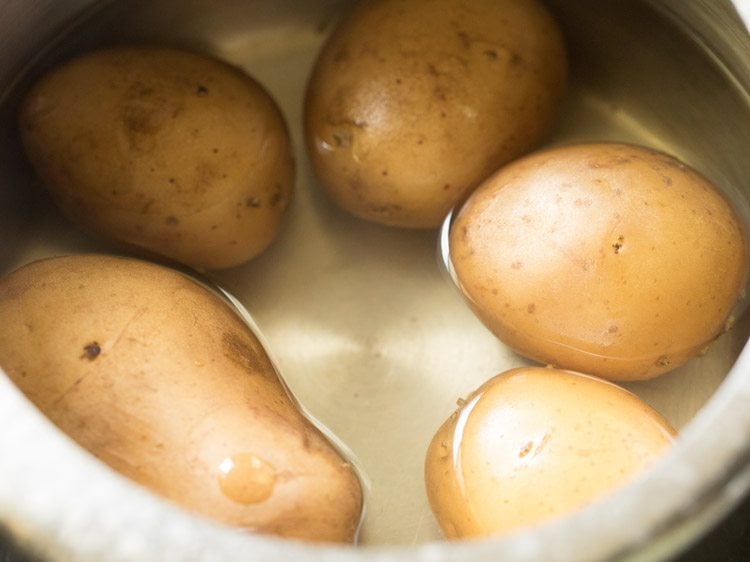
Check Doneness & Mash Potatoes Later
5. No matter how you have cooked the potatoes, you need to check if they are tender and softened.
1. For the stove-top pressure cooker, when the pressure settles down on its own in the cooker, then only open the lid and check the potatoes. Pass a knife or fork through the center of the potatoes and it should slide easily without any resistance.
2. For Instant pot, after you hear the beep when the pressure cooking is complete, wait for 5 minutes and then do a quick pressure release. Carefully, remove the potatoes with tongs and place them in a plate or tray. Check the potatoes to see if they are cooked tender with a fork or knife.
3. For pan, check the cooked potatoes with a fork or knife. Then using a strainer, drain all the water.
Whether you have cooked your potatoes on a stove-top or in the Instant Pot, you have to drain the water really well. Ensure that you do not have water logged in the cooked potatoes.
Let the potatoes become warm. Later peel and then chop them or crumble them. You can even mash them.
Remember to crumble or mash them really well. There must not be any potato chunks in the patty mixture.
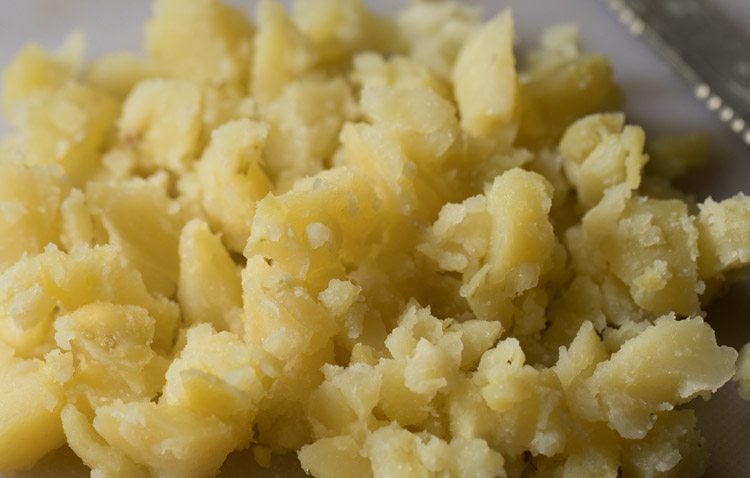
Roast & Crush Peanuts
6. When the potatoes are cooking, you can roast the peanuts. Heat a pan or kadai and add ½ cup peanuts in it.
If you have pre-made roasted peanuts, then skip these steps on roasting peanuts.

7. On a low to medium heat, stirring often roast the peanuts. Use a heavy pan, so that the peanuts do not get burnt.
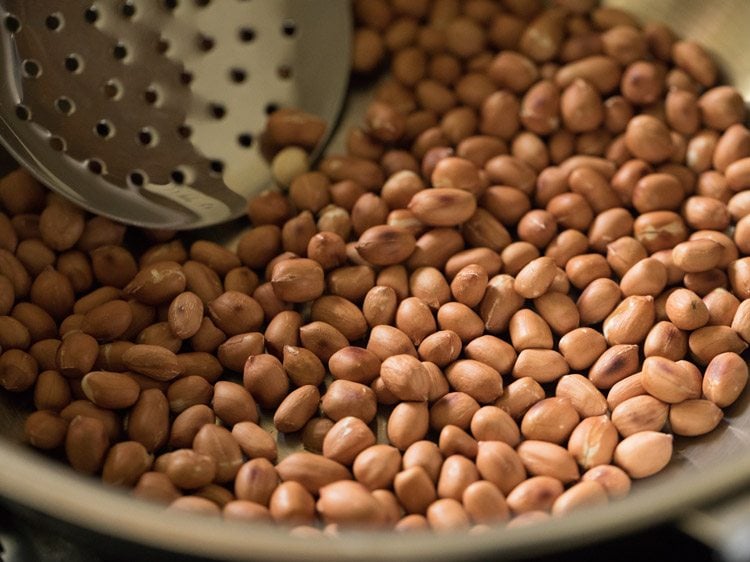
8. Roast the peanuts until you see a few black chars or spots on their husks. They should be crunchy and well roasted with no rawness or hardness in the center.
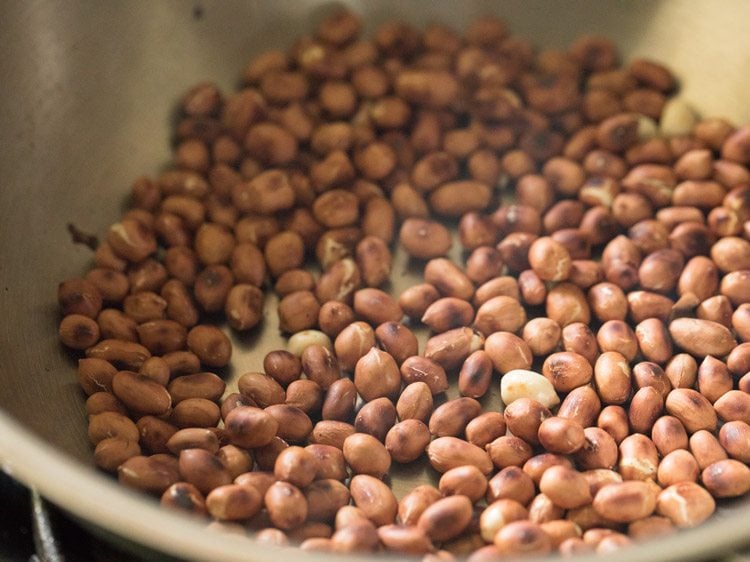
9. Transfer the peanuts to a plate and let them cool at room temperature. Once they are cooled, add them in a dry grinder or spice grinder. I have removed the husks. If you want you can keep them.
How to remove the peanut husks? Take the cooled peanuts in your palms and rub them with your palms over your kitchen sink, so that the thin husks fall in the sink and not fly all around in your kitchen.
You can also take them in a cotton kitchen towel. Bring the edges of the napkin in the center making a bundle and then rub the peanuts in the bundle with your palms.
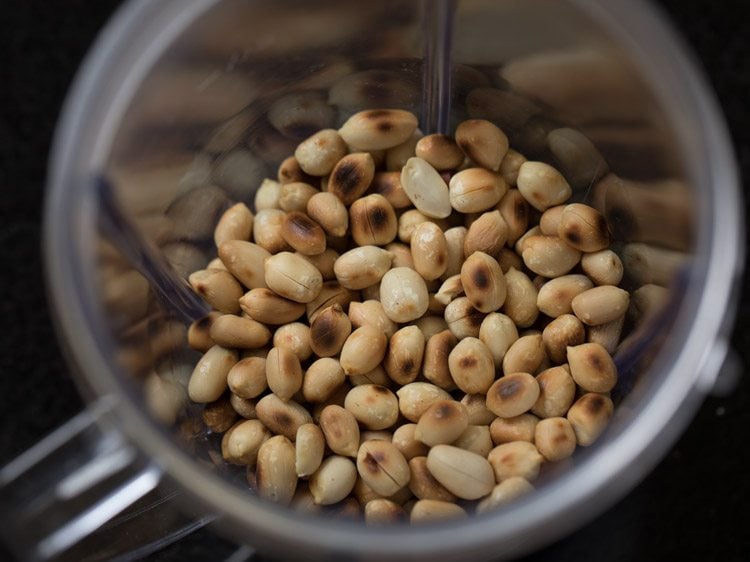
11. Grind to a semi-coarse powder. Keep the peanut powder aside. You can even make a fine powder if you like.
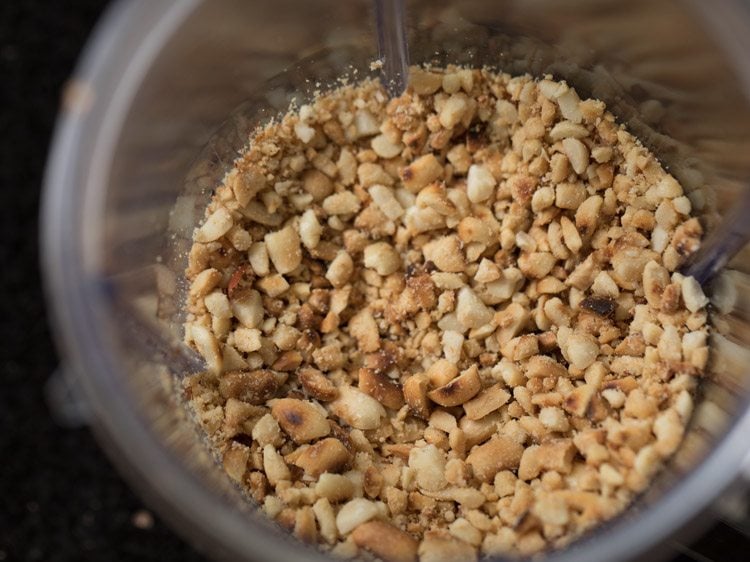
Make Sago Mixture
3. When the sabudana pearls are drained really well of any extra water, take the pearls in a mixing bowl.
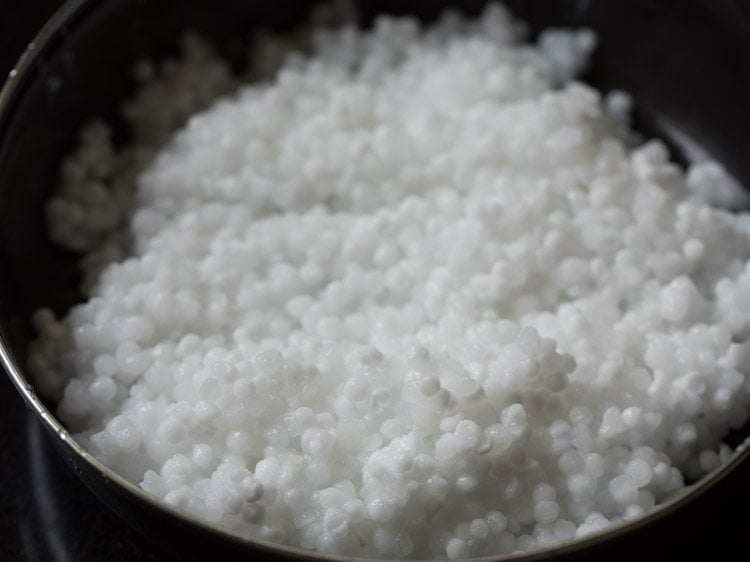
12. Add the mashed potatoes and coarsely roasted groundnuts to the sabudana in the mixing bowl.

13. Next add 1 to 2 chopped green chilies (about ½ to 1 teaspoon), 1 teaspoon peeled & finely chopped ginger and 2 tablespoons chopped coriander leaves.
You can skip coriander leaves if you do not have them.

14. Squeeze 2 teaspoons lemon juice or add according to your taste.

15. Now add 1 teaspoon cumin seeds, 1.5 teaspoons sugar and salt as per your taste. You can add less or more sugar as you like.

Mix and Shape into Patties
16. Combine and mix thoroughly with your hands or with a spoon. Check the taste and add more salt, sugar and lemon juice if needed.
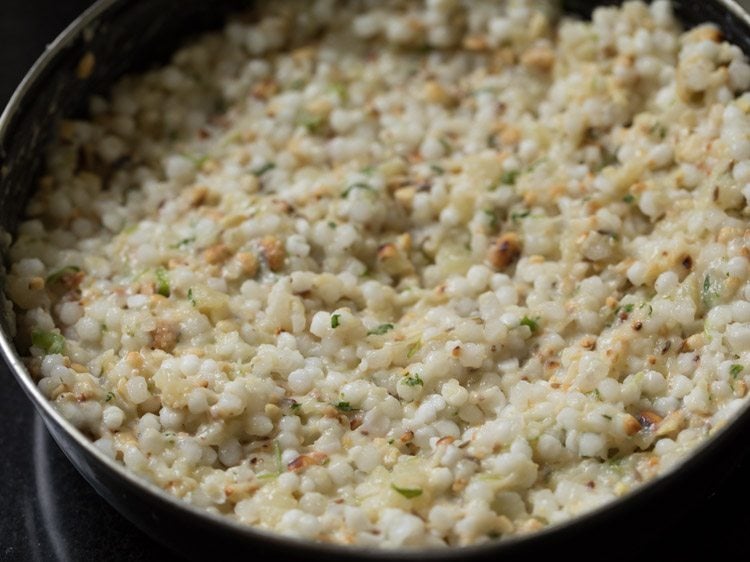
17. Now take some portion of the mixture in your hands and shape them into a flat round patty which is neither thin or thick. This way use up all of the sabudana dough mixture. Set the patties aside.
Tip: You can rub a bit of oil in your palms while forming the patties, so that the mixture does not stick to your palms.

Make Sabudana Vada
18. Heat oil for deep frying in a kadai (wok) or a pan. Keep the heat to medium. When you see the oil shimmering, add a small patty. It should come up steadily and gradually in the oil.
If it breaks in the oil, then there is more moisture in the mixture. To reduce the moisture, you need to add some binding ingredient.
So you can add some more boiled mashed potatoes (if you have it) or include 2 to 3 tablespoons of kuttu ka atta (buckwheat flour), singhare ka atta (water chestnut flour), ragjira atta (amaranth flour).
If making the vada as an evening snack for non-fasting days, add rice flour. Mix again and shape in patties. Ideally, do this step before you fry these patties.
Make sure to use a well-seasoned pan for frying so that the vada does not stick to it.
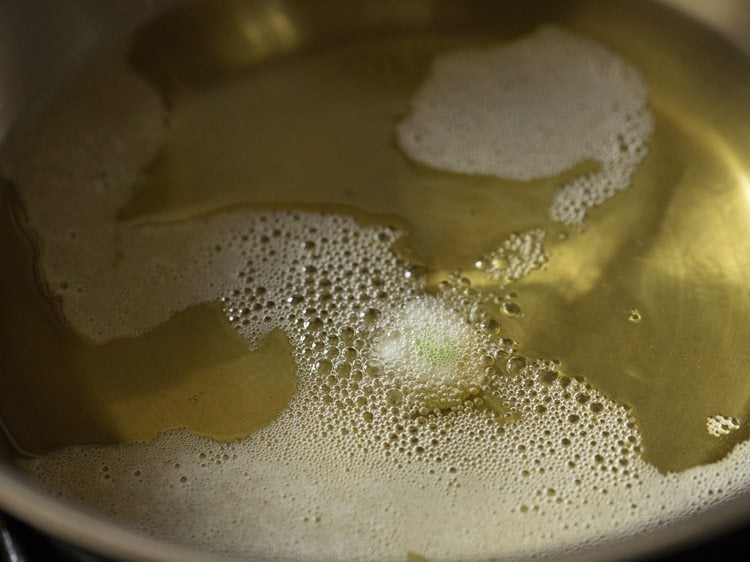
19. Gently place the patties in hot oil. Fry them at medium heat. Do not overcrowd the pan while frying.
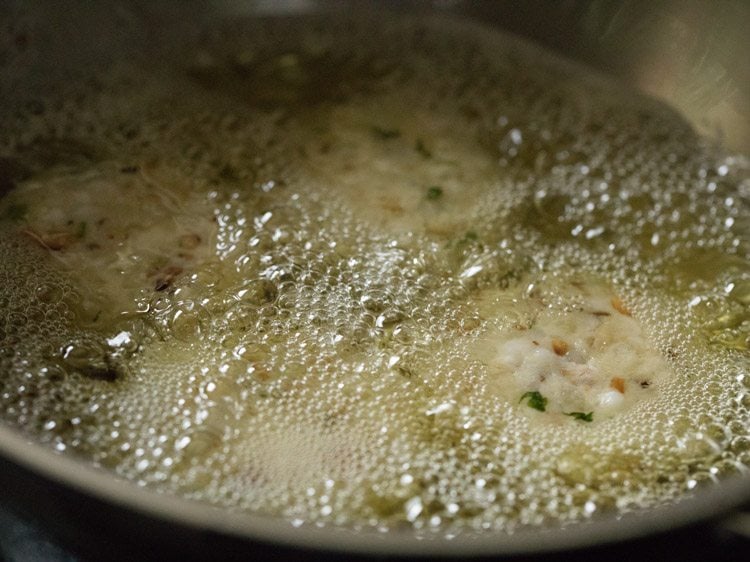
20. When one side is light golden, then only turn them over with a slotted spoon. Do not be in a hurry to turn them as the raw, under-cooked vada will fall apart in the oil.
When the vada looks crispy, light golden, then only gently turn them over.
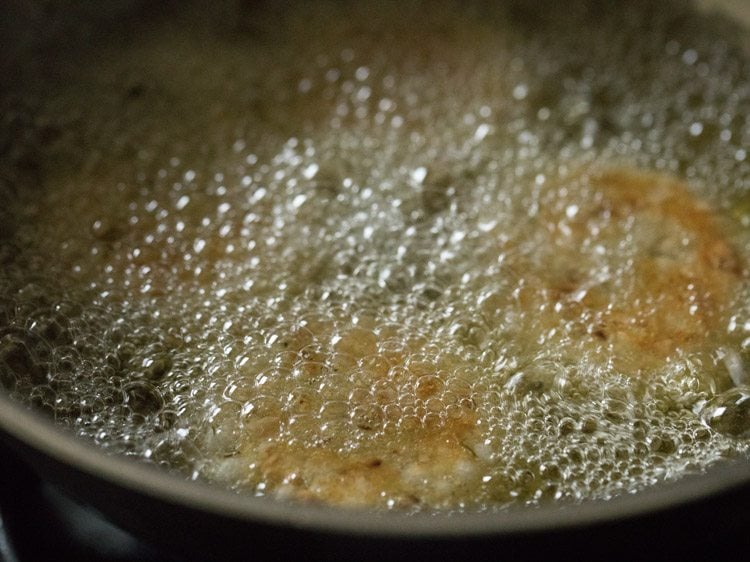
21. Turn over again when the second side is golden.
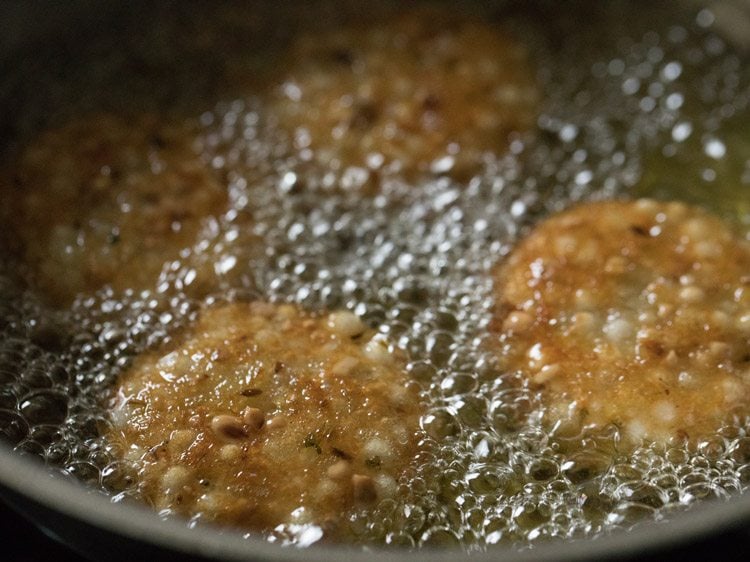
22. Continue to fry turning over a couple of times until the vada are evenly golden and crisp.

23. Remove the fried sabudana vada with a slotted spoon draining the extra oil in the pan.
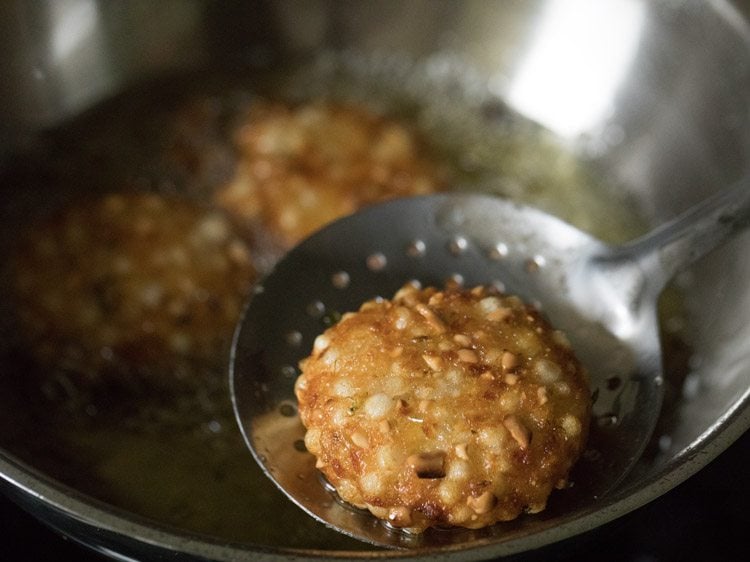
24. Place them on kitchen towels to absorb excess oil. Fry all the sago patties this way. Fry the remaining batches of the prepared vada in this manner.

Serving Suggestions
Sabudana Vada can be made for Hindu fasting days or an evening snack. It is crispy, delicious and tastes great with a simple Coconut Chutney and even sweetened Curd (Yogurt).
To make the sweetened curd, add some sugar to the curd and mix it. If short of time, you can even serve with sweet Tamarind Chutney or homemade Tomato Ketchup. You can also enjoy it with Coriander Chutney.
Serve Sabudana Vada hot or warm. In the photos, I served them with a sweet tamarind and red chilli chutney. I had made these as an evening snack.
Although they taste great while hot or warm, you could also opt to serve them at room temperature. A well made sabudana vada will remain soft even after it cools.

Make Ahead Options
To make ahead, boil, peel, mash and store the potatoes in your refrigerator a day prior. Roast peanuts and powder them. Refrigerate them for 1 to 2 days.
You can soak the sabudana a day earlier and keep it in the refrigerator after draining the water. Any leftover dough mixture stays well in the fridge for 1 to 2 days.
Expert Tips
1. Soaking Sabudana
The sabudana (sago) has to be really soaked well. Not even a little hardness should be left in the sago as these will shatter or burst in the oil when frying.
The water needs to be drained well. Use a sieve or a colander to drain the water. If there is moisture in the mixture, then you won’t get a proper shape of the vada and they will get soggy. As a result they will soak up a lot of oil and can even fall apart or burst in the hot oil.
2. Potatoes
The starch in the potatoes help to bind these sago patties. Be sure to use potatoes which have a high to medium starch content.
Avoid the type of potatoes like new potatoes or baby potatoes that have a low starch content; as it will not be easy to bind the patty mixture and the sabudana vada may fall apart or shatter in the oil while frying.
3. Roasted Peanuts
You could use roasted peanuts which are unsalted. Only if the peanuts are not roasted, then you need to roast them. You can make ahead the roasted peanuts, powder them and refrigerate for 1 to 2 days.
If they are roasted, then on roasting the skin becomes flaky and you can remove the skin easily from the peanuts with your fingers or with the methods I have described in the step-by-step guide above.
About Frying and Oil Temperature
Ideally the temperature of the oil for deep frying must be 180 degrees Celsius to 190 degrees Celsius (360 degrees Fahrenheit to 375 degrees Fahrenheit). With a deep fry or candy thermometer you can easily measure this temperature.
Worry not, if you do not have a thermometer. You can check the temperature by adding a small shaped vada in the oil.
If it emerges on the surface gradually, and is sizzling, bubbling, the oil is ready. If the patty comes up slowly or is sunk at the bottom of the pan, the oil is warm. The oil is very hot, if it rises up on the surface too quickly or briskly.
If the oil is hot, the patties will burn from outside leaving the inside portion uncooked. A lukewarm oil will lead to the patties absorbing more oil, making them loaded and soggy with oil.
For a more crisper texture, you need to brown them a little extra. This can be achieved by frying for a few minutes more.
If the vada or patties fall apart or bursts while frying, then add some flour (buckwheat, amaranth, water chestnut flour) into the vada mixture. If not making as a fasting snack, then add rice flour.
Ingredients Swaps & Variations
- With Sweet Potato: Swap potatoes with sweet potatoes and make a sweet tasting sago vada. Boil or steam the sweet potatoes first in enough water. Once tender and softened, let them cool. Later peel and mash before mixing it with the other ingredients.
- With Onions: Normally onions and garlic and never added in the traditional sabudana vada recipe. If you are willing to experiment, you can add onions or garlic to the vada dough mixture.
- Nuts: An authentic and traditional sabudana vada recipe always features peanuts. If you do not have peanuts, make the vada without them or swap with cashews. Some fresh grated coconut (about 2 tablespoons) can be added to the vada mixture.
- Herbs: Feel free to omit coriander leaves in this sago vada recipe. You can replace coriander with about 1 tablespoon of mint leaves or add about 1 tablespoon of chopped curry leaves. Note that the taste and flavor will change with either mint or curry leaves.
- Spices: The only spice that gives some heat and pungency in the sabudana vada recipe are green chillies. Opt to add some crushed black pepper (about ½ teaspoon) instead of green chillies. For a spicy taste and when not making for the fasting time, add ½ to 1 teaspoon of red chilli powder or cayenne pepper.
- Scaling: According to your needs, you can easily halve, double or triple this sabudana vada recipe.
FAQs
Why does my Sabudana Vada break in oil?
If the dough mixture has more moisture or if there is not enough binding from the potatoes, the sago patties will break and fall apart in oil.
How long does sabudana take to soak?
It is best to soak sabudana for 4 to 5 hours. Though depending on how hard the sabudana pearls are, the time will vary from a couple of hours to overnight.
So try testing the sabudana you have and ensure that the pearls are tender and softened well after soaking.
Can I boil Sabudana instead of soaking?
No, please never do that. All you will get is a gluey, starchy mixture that will never bind and will be a mess.
Can we store soaked Sabudana in the fridge?
Yes, you can store the soaked sabudana fridge for 1 to 2 days. Store them in a covered container.
Can I bake or air-fry Sabudana Vada?
You get the best texture and taste from deep frying these vadas. If you are feeling experimental, you can try to bake or air-fry, but you won’t get a truly crispy, fluffy and softer texture. They may be slightly undercooked or chewy.
Step by Step Photo Guide Above

Sabudana Vada Recipe (Maharashtrian Style)
Ingredients
- 1 cup sabudana (sago or tapioca pearls)
- 4 potatoes – medium-sized
- ½ cup peanuts
- 1 teaspoon cumin seeds – optional
- 1 to 2 green chillies – finely chopped or ½ to 1 teaspoon
- 1 teaspoon ginger – finely chopped
- 2 teaspoons lemon juice (optional)
- 2 tablespoons chopped coriander leaves – optional
- 1.5 teaspoon sugar or as required
- 1 to 2 tablespoons buckwheat flour or amaranth flour – optional
- rock salt (edible and food grade) or sendha namak
- oil as required, for deep frying
Instructions
Soaking Sabudana
- You need to plan ahead and soak the sago pearls. It is very important to soak the sago really well.Important: Please refrain from using un-soaked or under-soaked sabudana to avoid scalding or burns as they will burst and shatter in oil when frying.
- First optionally, using a colander or mesh strainer rinse 1 cup sabudana lightly twice draining all the water.
- Soak the sabudana or sago in water for 5 hours at least or overnight. I soaked the sago pearls overnight and by morning they had become soft.
- When properly soaked, the sabudana pearls will be tender without any hard center. When you press the pearls between your forefinger and thumb, they should get mashed easily with a floury moist texture on your fingers.
- If you feel some hardness in the center, then soak for some more time. Drain all the water really well from the soaked sabudana.
- There should not be any water logged in the soaked pearls. Water will make the patties moist and sticky. The patties will soak up a good amount of oil while frying making them loaded with oil. So drain the water really well.
- You can opt to gently and lightly press the soaked pearls in the strainer with a spoon or spatula. Or set aside the pearls in a strainer (keeping a bowl beneath) for some 20 to 30 minutes dripping of any extra water.
- After draining the water thoroughly transfer the sabudana in a mixing bowl and set aside.
Cooking Potatoes
- Scrub and rinse 4 medium-sized potatoes thoroughly in water first.
- 1. Stove-top pressure cooker: Place the potatoes in a 3 litre cooker. Add water which just about covers the potatoes. Pressure cook potatoes for 10 to 12 minutes or 4 to 5 whistles on medium heat.When the pressure settles down on its own in the cooker, open the lid and check the potatoes. Pass a knife or fork through the center of the potatoes and it should slide easily without any resistance.
- 2. Cooking in a pan: Take water and add peeled and chopped potatoes. The water should cover the potatoes. Add a 2 to 3 pinches of salt if preferred.Cover and simmer potatoes until fork tender. Drain the water really well. When the potatoes are tender, using a strainer, drain all the water.
- 3. For Instant Pot cooking: Place a trivet in the inner steel of your Instant Pot. Add 1.5 cups water. Place the rinsed potatoes on the trivet. Seal with the lid and position the valve to sealing. Press the manual/pressure cook button and set the time to 10 or 12 minutes with high pressure option.After you hear the beep when the pressure cooking is complete, wait for 5 minutes and then do a quick pressure release. Remove the potatoes with tongs and place them in a plate or tray. Check the potatoes to see if they are cooked tender with a fork or knife.
- Let the potatoes become warm. Later peel and then chop them or mash them.
Roasting Peanuts
- On a skillet or in a shallow pan, roast the groundnuts/peanuts till they become crisp and crunchy.
- Cool and then coarsely powder in a mortar-pestle or in a dry grinder. You can even make a fine powder.
Making Sago Mixture
- Add the mashed potatoes and coarsely ground roasted groundnuts to the sabudana in the mixing bowl.
- Add edible rock salt, cumin seeds, sugar, ginger, green chillies, coriander leaves and lemon juice to the sabudana . Mix the entire mixture very well.
- Now take some portion of the mixture in your hands and shape them into flat round vada or patty. Set aside.
- Repeat until you use up the entire dough mixture.
Making Sabudana Vada
- Heat oil for deep frying in a kadai. Add a tiny ball made from the mixture.
- Fry it on medium flame. If this ball does not break while frying, then you are good to go.
- If it breaks, then add 1 to 2 tablespoons of rajgira atta (or amaranth flour) to the mixture and mix well.
- Now gently place the vada in the oil. Keep the heat to medium or medium-high while frying. If the oil is warm, the vada will absorb a lot of oil and become soggy.
- Add the vada for frying depending on the size of the kadai. Do not crowd the kadai or pan.
- When one side gets golden, then only flip the vada. Otherwise, don't even touch as they might break if not cooked.
- Turn over a couple of times so as to fry the sabudana vada evenly. Fry until they are crisp and golden
- Remove them with a slotted spoon. Place on kitchen paper towels to absorb excess oil. Fry the remaining batches of the patties this way.
- Serve Sabudana Vada hot or warm.
Serving Suggestions
- Sabudana Vada can be made for Hindu fasting days or an evening snack too. It is crispy and delicious and thus tastes great with simple Coconut Chutney and even sweetened Curd (Yogurt).
- To make the sweetened curd, you will just need to add some sugar to the curd and mix it. If short of time, you can even serve with sweet Tamarind Chutney or tomato ketchup.
- You can also enjoy it with Coriander Chutney.
Make Ahead Options
- To make ahead, boil, peel, mash and store the potatoes in your refrigerator a day prior. Roast peanuts and powder them. Refrigerate them for 1 to 2 days.
- You can soak the sabudana a day earlier and keep it in the refrigerator after draining the water.
- Any leftover dough mixture stays well in the fridge for 1 to 2 days.
Video
Notes
- Soaking: The sabudana (sago) has to be really soaked well. Not even a little hardness should be left in the sago as this will cause the sago to burst in the oil while frying.
- Moisture: The water needs to be drained well. Use a strainer or a colander to drain the water. If there is moisture in the mixture, then you won’t get a proper shape of the vada and they will become soggy from inside. As a result they will soak up a lot of oil while frying and can fall apart in the hot oil.
- For a more crispy vada: For an extra crispy texture, you need to brown the vada a little extra. This can be achieved by frying for a few minutes more.
- Premade roasted peanuts: You could use roasted peanuts which are unsalted. Only if the peanuts are not roasted, then you need to roast them. You can also roast the peanuts a couple of days before and then use them in the recipe. If they are roasted, then on roasting the skin becomes flaky and you can remove the skin easily from the peanuts with your fingers.
- Binding: If the patties breaks or bursts while frying, then add some flour (buckwheat, amaranth, water chestnut flour) in the vada mixture. If not making as a fasting snack, then add rice flour.
Frying & Oil Temperature Ideally the oil must have a medium to medium-high heat. You can check the temperature by adding a small shaped vada in the oil. If it emerges on the surface gradually, and is sizzling, bubbling, the oil is ready. If the patty comes up slowly or is sunk at the bottom of the pan, the oil is warm. The oil is very hot, if it rises up on the surface too quickly or briskly. If the oil is too hot, the patties will burn from outside leaving the inside portion uncooked. A lukewarm oil will lead to the patties absorbing more oil, making them loaded and soggy with oil. A very hot oil will burn the patties from outside leaving the inside portion under cooked. If the oil is warm, the patties will absorb oil, making them loaded with oil and soggy. Variations
- With Sweet Potato: Swap potatoes with sweet potatoes and make a sweet tasting patties.
- With Onions: Traditionally onions and garlic and never added to the fasting sabudana vada recipe. If you are willing to experiment, you can add onions or garlic to the vada dough mixture.
- Nuts: Again an authentic and traditional sabudana vada recipe always features peanuts. If you do not have peanuts, make the vada without them or swap with cashews. Some fresh grated coconut (about 2 tablespoon) can be added to the vada mixture.
- Herbs: Feel free to omit coriander leaves in the recipe. You can replace coriander with about 1 tablespoon of mint leaves or add about 1 tablespoon of chopped curry leaves. Note that the taste and flavor will change with either mint or curry leaves.
- Spices: The only spice that gives some heat and pungency in the recipe are green chillies. Opt to add some crushed black pepper (about ½ teaspoon) instead of green chillies. For a spicy taste and when not making for the fasting time, add ½ to 1 teaspoon of red chilli powder or cayenne pepper.
- Scaling: According to your needs, you can easily halve, double or triple this recipe
Nutrition
Sabudana Vada recipe from the blog archives was first published on September 2009.

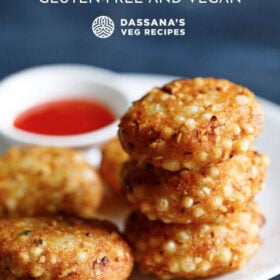
The sabudana vada turned out well.
Thanks for the recipe.
I love gluten-free recipes like this. Instead of potatoes I’d like to try to using cassava. Thanks for sharing.
Your recipes are fail proof and never cease to amaze despite the simplicity. Can you help me please my sabudana vada mix turns out really dry. What can I add or is it because the sabudana hasn’t been soaked properly?
Thanks. Could be that the sabudana has not been soaked properly. If they have been soaked well, on pressing them, they should mash easily. Try soaking for some more time. I hope this helps.
Just Wow
thank you.
I love your recipes!! Your blog is my go to place every time i want to cook something new.
Sabudana vada soak up a lot of oil, in order to reduce oil consumption, can we bake these vada?
thank you kratika. yes you can bake sabudana vada. bake at 180 degrees celsius till they get a golden crust on top. brush with some oil before baking. timing will vary with the type, make and size of the oven.
Very nice!Your all recipes are delicious!Wish you to write about other recipes.Regards.,
thanks.
Hi Dassana../
Is there a way to keep the vada crisp until the next day? I’ve made a batch tonight to be taken to the office tomorrow.. already some of them have turned soft on the outside..
nishita, sabudbana vada are best served hot as they are crisp when served hot. after a few hours they turn soft and do not remain crisp. so there is nothing that can be done. actually this happens with most fried goods. to make them less soft, let the vada become warm or cool at room temperature. then you pack them in tiffin. when packed hot, the heat releases when the sabudana cools and condenses. this makes them more soft.
Big fan of yours..Detailed recipe with tips leave no room for doubt..my favourite is your Besibele bhath recipe..
Thank you for making life simpler in kitchen????????
Welcome Vijaya. Thanks for your kind words and positive feedback on recipes.
Can this recipe be doubled or tripled?
archana, you can easily double or triple this sabudana vada recipe.
As I have got married recently and my father in law is fasting for Navratri so I have used your recipe,vada is come out super well and it tastes yum ❤️ thank you so much !
welcome raksha. glad to know that you liked sabudana vada recipe.
Great recipe. Turned out perfect.
One question though: can we bake these?
thanks priya. i am not sure if sabudana vadas can be baked. but to cut down on the oil, you can make them in an appe pan or paniyaram pan.
Very easy method for sabudana vada.
thanks pranita
Hi Dassana,
I’ve written in earlier on a few occasions praising your recipes. However this time it’s not for telling you how well a particular recipe has come / thanks for sharing the recipe, but to let you know that there seems to be some problem with your website. It takes a very long time to load (sometimes even as long as 5 minutes), and even after refreshing again and again, going back to the google page and trying again, it still does not load. I don’t have this problem with other sites, (including other blogs/ recipe websites I follow), which are loading immediately (in fact before writing to you I checked that first thinking it may be a problem with my internet but it’s working fine for other sites). So it seems to be a problem with your hosting service provider or the website/blog itself. In order to write this message itself I had to wait a long time and refresh a few times before it loaded.
Just thought I’d drop in and let you know in case you don’t know of this issue.
Could you please look into it as we don’t want to miss your awesome recipes!
Thanks,
Deepa
hi deepa, thanks for letting me know about this issue. no other readers has yet told us about this problem. also from our end on laptops and mobiles we can easily access the website. i am not sure why this happening at your end. could be your isp provider is blocking the website or some program/app/software in the website. so difficult to find out. it could be a local issue with your isp provider or computer. for me it will be difficult to find out and the server guys are not very responsive and helpful. so i do not know what can be done. anyways thanks for letting me know.
I try every reciepe from your blog and it comes out fantastic…..
Thanks Bharathi for sharing positive feedback on recipes.
Thanks for nice and simple recipe for sabudana vada
welcome anand 🙂
Hi I make it every once in every month for my son and hubby as they love it but it never comes soft so can I add rice flour instead of the the flour u added will that make it soft
anandi, you can add rice flour. the sabudana vadas will become soft with rice flour.
Simple amazing receipes. I always come to your site when I am to try my hands in cooking. I learnt bread making from you.
Thanks Vishal
thank you much vishal.
could the sabudana and alu mixture be stored overnight??
chaganti, yes you can.
The Sabudana I have dissolves really fast. How can I prevent that if I want to soak it for that long? Is there a certain brand of Sabudana that’s better?
There is no brand. Just soak sabudana for 30 minutes to 1 hour. Just check if they are soaked well after 30 minutes. If not then soak further.
Just like to know my vadas are not being fried well. They are breaking in oil . what’s the reason. Kindly guide me.
there must be more moisture in the sabudana. the soaked sabudana have to be drained very well of all the water. you could also add some more mashed potatoes to bind the mixture or add some more buckwheat flour or amaranth flour, which in turn will excess absorb moisture.
I really love the simplicity of your recipes.
The pictorial depiction adds such good value that there is no need to read further.
I refer to your site every time I want to cook veg food esp to impress a guest.
Thank you
welcome roshni. glad to know that you liked the recipes presentation.
Really nice recipe. Thank you for sharing it. 🙂
welcome aastha
I would want to know what is “kuttu ka atta/buckwheat flour or amaranth flour”. I am a Hyderabadi and doesn’t know what we call this here, don’t understand this flour.
I am eager to try this as it looks so yummy.
Thanks for sharing.
welcome uzma. i am sorry, i don’t know whats the name of this flour in telgu language.
Hi , Can we shallow fry it ? & I think saudana pakora & vada ,are both the same ,know ? Only change of name ! I love sabudana . Had deep fried it earlier ,was thinking if I can shallow fry it this time ? Will it change the taste ?
neena, yes you can shallow fry it. they are different recipes.
Hi , Had made sabudana vada & kheer yesterday. Wow ! It came out very well & was delicious . In order to keep the moisture dry ,I just roasted it in the pan . And then mixed it with aloo & other ingredients. Everybody loved it .Thanks soooo much .
welcome neena. thanks for sharing the tip and for your positive feedback on sabudana recipes.
Absolutely gorgeous recipe! Made today and they were super hit… ! finally, my search for a perfect and scrumptious sabudana vada recipe has ended.
thanks deepti. glad to know that you liked the sabudana vada recipe.
my son loved it. I didn’t have amarnath flour…used corn flour instead
thanks mira for the feedback.
Thank YOU for all the efforts you do for writing this blog after all that hard work on the cooking the meal itself! Really in love with your recipes ! keep it up !
welcome deepti. thanks for sharing this sweet feedback.
Mouth watering vadas….they just melt in the mouth!! Made it as a diwali snack and my hubby loved it. He had never tasted them before as they are not made in South India….I used to love eating them in Mumbai with sweet curd….thanks for a wonderful recipe!!
welcome dhanya. glad to know that you both enjoyed the vadas.
its really fantastic thank you
welcome saisaranya
vada looks perfect ..Yummy and tasty
thanks sathya
I love sabudana vada, but I was not knowing hw to make it. It was my brothers birthday and i tried and made it in the party and seriously all of them liked it…. Because of u dassana i made my broz birthday special… thanks alot!!! 🙂
thats great to know saima. thanks for taking the time to comment and giving your feedback.
Ok..thanks.What about corn flour?
shalini, same thing. taste will be different. you can try with corn flour.
Ok,thanks!
welcome shalini
Hi,
Can we use maida instead of kuttu atta for binding?
shalini, the taste and texture will change with maida. i suggest better option is rice flour.
Thanks for all ur detailed recipes. M sure it takes a lot of time n patience with all these step by step click.. Wanted to clarify as to What’s the proportion of ‘soaked’ sabudana to boiled potatoes ?
i have not measured the soaked sabudana. hence cannot help you in this. as a rule, there should be enough potatoes which help in binding and also make the vadas soft. if the amount of potatoes added are less, then the sabudana vada become crispy.
hye dassana,
i have been following up your recipes.. and trust whatever i made till now following your recipes turned out very nice. one thing i wan to ask when i made sabudana vada i dont knw what went wrong when i started frying the vada in oil they started breaking. please help me out with these.
i think the amount of mashed potatoes were less. the potatoes help in binding. if you add some singhara ka atta or kuttu ka atta, these also help in binding. did you drain the water very well from the sabudana. there should be no water or moisture in the soaked sabudana. the mixture has to be dry with no moisture.
tasty and tempting vada
Nice recipe.
Wonderful recipie . . Saved my day and made my hubby happy 🙂
thanks
I really like the way this recipe is presented & explained….
thanks bhavna.
what is aara lot or arrowroot flour
I think this wikipedia link mentions in detail about arrowroot powder and its ingredients: https://en.wikipedia.org/wiki/Arrowroot
It is used a subsititute for corn starch and is gluten free. It is used as a thickener to thicken puddings, gravies, soups, broths and sauces. It is also used in the preparation of biscuits, cookies, cakes, waffles, pancakes and icecreams.
I do not know where you stay, but in India, it is easily available and is called in Hindi as arraroot powder.
The reply is posted here on the below link:
https://www.vegrecipesofindia.com/sabudana-vada-recipe-how-to-make-sabudana-vada-recipe/comment-page-1/#comment-1997